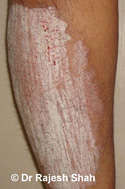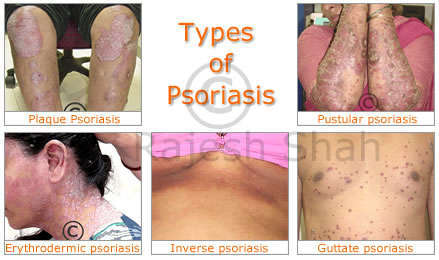Symptoms and Types of psoriasis
Although psoriasis may be almost unnoticeable in its early stages, patients often report an itching and/or burning sensation as the disease progresses.
 This photo on the left shows itching (skin after itching) and bleeding spots thereafter, on psoriasis lesions. In this photo, the patient has scratched it profoundly to the extent that there are bleeding spots. (Click photo to enlarge.)
This photo on the left shows itching (skin after itching) and bleeding spots thereafter, on psoriasis lesions. In this photo, the patient has scratched it profoundly to the extent that there are bleeding spots. (Click photo to enlarge.)
There are many variants and types of psoriasis. But usually, the course follows like this: It starts with red small bumps on the skin that progress to bigger scaly patches. The condition is associated with a lot of itching. As the scales accumulate, pink to deep red plaques with a white crust of silvery scales appear on the skin surface.
Although psoriasis may affect any area of the body, it is most commonly found on the scalp, elbows, knees, hands, feet, and genitals.
Types of psoriasis:
Psoriasis has many variants. The common ones are as follows:

- Plaque psoriasis is the most common type of the disease and is characterized by raised, thickened patches of red skin covered with silvery-white scales. Its scientific name is psoriasis vulgaris.
- Scalp psoriasis is a common variant of Psoriasis, which is relatively more difficult to treat. Please click on the link to read an elaborate write up on scalp psoriasis.
- Pustular psoriasis: is characterized by pus-like blisters. Attacks of pustular psoriasis may be triggered by medications, infections, emotional stress, or exposure to certain chemicals. Pustular psoriasis may affect either the small or large area of the body. Psoriasis video shows this variety.
Video on Pustular psoriasis
- Erythrodermic psoriasis characterized by intense redness and swelling of a large part of the skin surface is often accompanied by itching or pain. Erythrodermic psoriasis may be precipitated by severe sunburn, use of oral steroids (such as cortisone), or a drug-related rash.
Video on Erythrodermic psoriasis
Video of Palmo-planter Psoriasis
Palmo-plantar psoriasis is characterized by the appearance of red patches of skin topped with scales typical of psoriasis on the palms and elsewhere on the body. There are thickening and scaling of the skin accompanied by the formation of deep, painful fissures on the palms and soles. It is commonly seen that some substances, such as detergents, washing up liquid and cleaning products, irritate lesions and prevent them from healing. One should be careful not to wash hands too often, and not to use water which is too hot, as this dries the skin. Psoriasis video shows this variety.
- Guttate psoriasis is characterized by small, drop-like lesions on the trunk, limbs, and scalp. Guttate psoriasis is most often triggered by bacterial infections (for example, Streptococcus).
- Palmo-planter psoriasis is a common variant of Psoriasis affecting either the palms or soles or palms as well as soles. Palmo-plantar psoriasis is a chronic, recurring condition that affects the palms of hands and soles of feet.
- Inverse psoriasis is characterized by smooth red lesions in the folds of the skin like in the folds of the skin near the genitals, under the breasts, or in the armpits. Inverse psoriasis is related to increased sensitivity to friction and sweating and may be painful or itchy.
For the most part, people with psoriasis can function normally. Sometimes people experience low self-esteem because psoriasis appears unsightly. Psoriasis is often misunderstood by the public, and this can make social interactions awkward. This may lead to emotional problems such as anxiety, anger, embarrassment, and depression.
- The Psoriatic Nail About 50 percent of persons with active psoriasis have psoriatic changes in fingernails and/or toenails.
.gif) In some instances, psoriasis may occur only in the nails and nowhere else on the body. Nail changes in psoriasis fall into general categories that may occur singly or all together:
In some instances, psoriasis may occur only in the nails and nowhere else on the body. Nail changes in psoriasis fall into general categories that may occur singly or all together:
- The nail plate is deeply pitted or depressed
- The nail has a yellow to yellow-pink discoloration
- White areas appear under the nail plate. There may be reddened skin around the nail.
- The nail plate crumbles in yellowish patches (onychodystrophy)
- The nail may be entirely lost
- Psoriatic arthritis: Psoriatic arthritis is all the more difficult situation where you find psoriasis associated with joint pain (arthritis). This shows deeper affection of the underlying problems.
Video on Psoriatic arthritis
The changes in the blood which lead to psoriasis are now also bringing changes in the joints, which could even be irreversible. Any joint could be affected in this process. The joint affection relatively becomes more difficult to treat. Interestingly, there is a good treatment for psoriatic arthritis in homeopathy, especially if treated in the early stages.
Written & Approved by-
Dr. Rajesh Shah
M.D. (Hom.)